Analysis of Media Learning Activities and Commentary for DMIL 2016
VerifiedAdded on 2020/05/16
|18
|3834
|141
Report
AI Summary
This report, focusing on media learning activities and commentary for the DMIL 2016 course, delves into the core elements of teaching and learning in digital media. It outlines various activities including applied learning for content development, designing graphical representations, personal research, and online collaborative learning. The report explores the importance of these activities for undergraduate learners, emphasizing the development of professional skills and the application of technology in simplifying complex data. It also includes a commentary section that discusses the pros and cons of each teaching method, referencing key theories such as the Six Frames for Information Literacy Education and the model of literacy. Furthermore, the report addresses the challenges associated with these learning activities and concludes with a reflection on the overall effectiveness of the proposed strategies. Detailed sections cover content development, image creation, and the use of audio-visual technology, providing practical examples and expected outcomes for each area. Finally, the report highlights the importance of research credibility and management systems within the digital media landscape, offering insights into virtual management and its implications for future professionals.
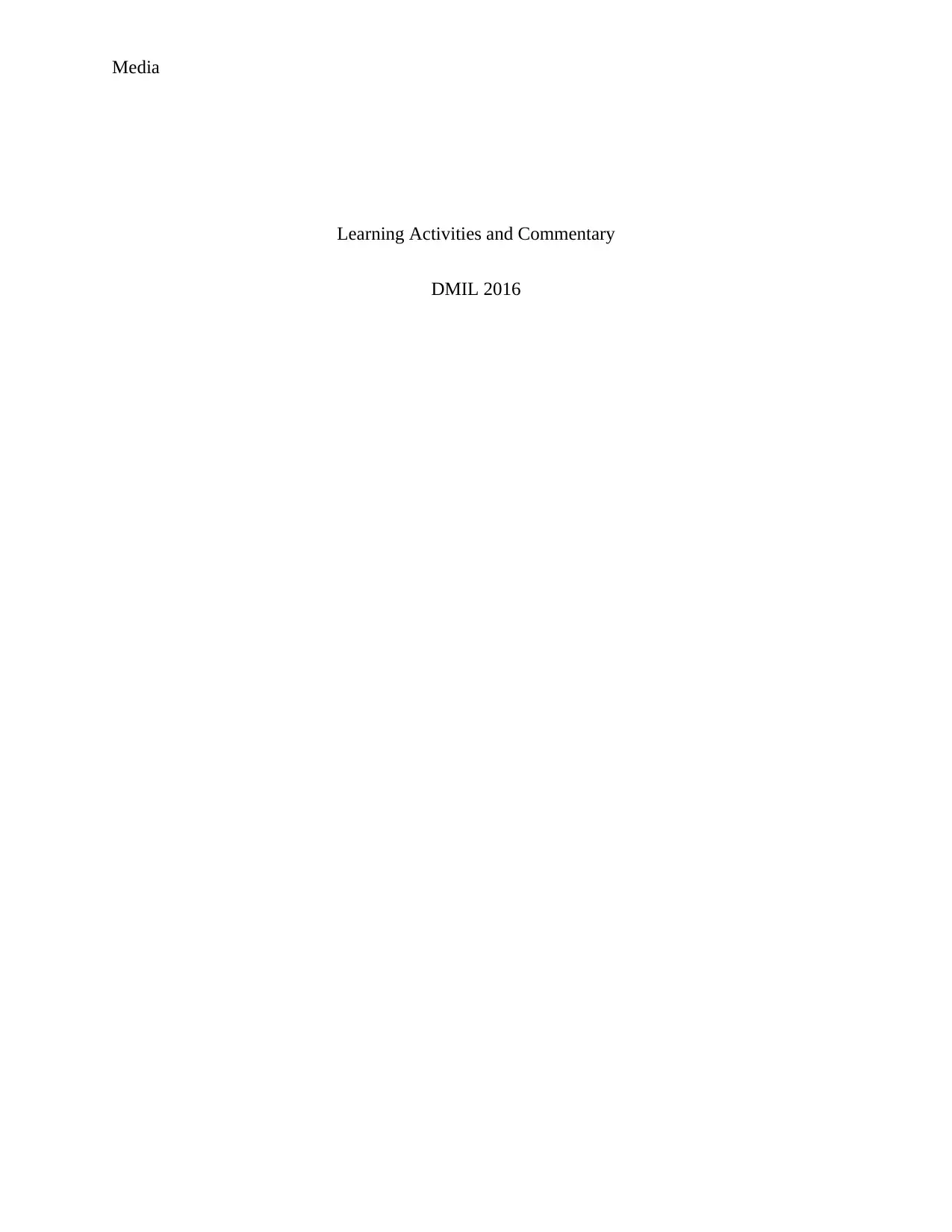
Media
Learning Activities and Commentary
DMIL 2016
Learning Activities and Commentary
DMIL 2016
Paraphrase This Document
Need a fresh take? Get an instant paraphrase of this document with our AI Paraphraser
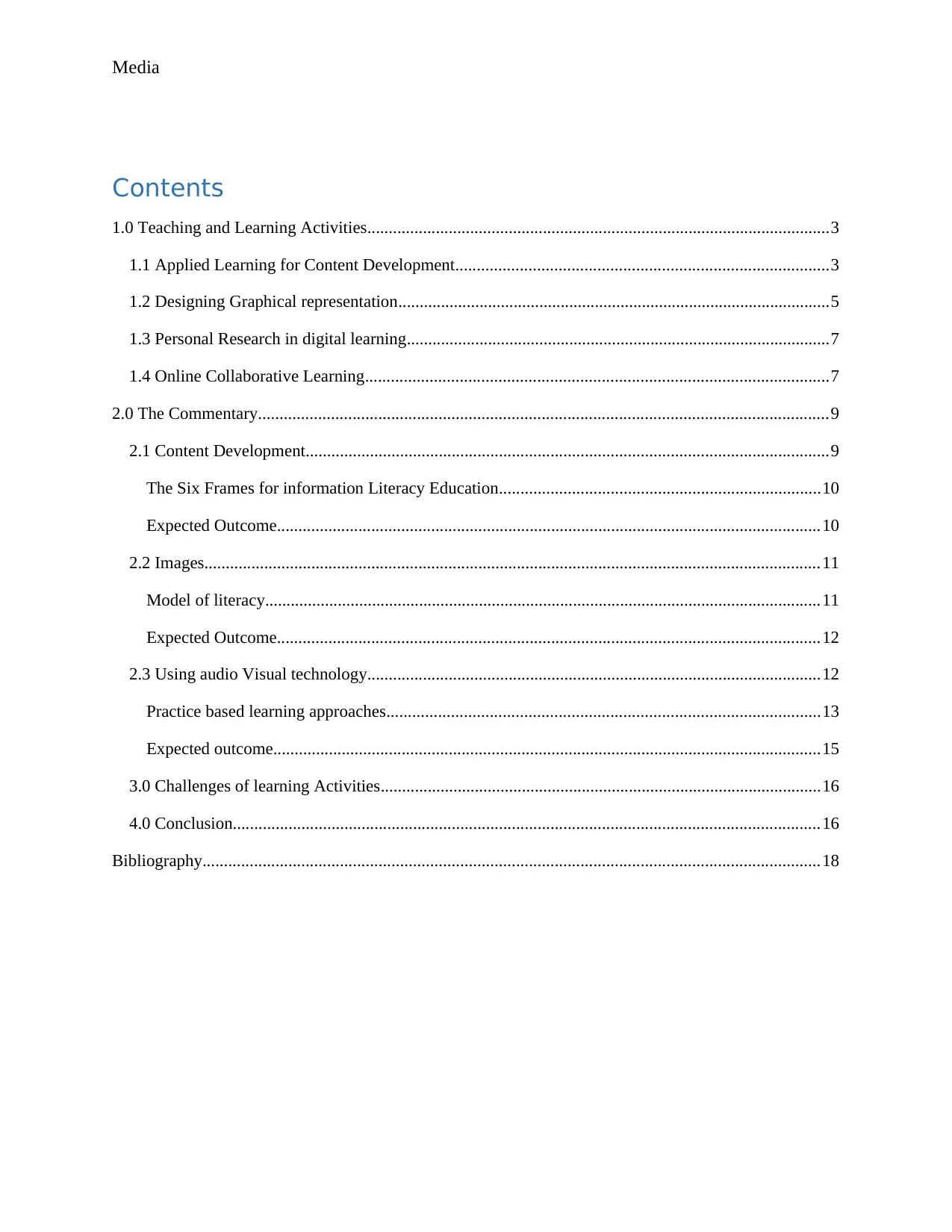
Media
Contents
1.0 Teaching and Learning Activities............................................................................................................3
1.1 Applied Learning for Content Development.......................................................................................3
1.2 Designing Graphical representation.....................................................................................................5
1.3 Personal Research in digital learning...................................................................................................7
1.4 Online Collaborative Learning............................................................................................................7
2.0 The Commentary.....................................................................................................................................9
2.1 Content Development..........................................................................................................................9
The Six Frames for information Literacy Education...........................................................................10
Expected Outcome...............................................................................................................................10
2.2 Images................................................................................................................................................11
Model of literacy..................................................................................................................................11
Expected Outcome...............................................................................................................................12
2.3 Using audio Visual technology..........................................................................................................12
Practice based learning approaches.....................................................................................................13
Expected outcome................................................................................................................................15
3.0 Challenges of learning Activities.......................................................................................................16
4.0 Conclusion.........................................................................................................................................16
Bibliography................................................................................................................................................18
Contents
1.0 Teaching and Learning Activities............................................................................................................3
1.1 Applied Learning for Content Development.......................................................................................3
1.2 Designing Graphical representation.....................................................................................................5
1.3 Personal Research in digital learning...................................................................................................7
1.4 Online Collaborative Learning............................................................................................................7
2.0 The Commentary.....................................................................................................................................9
2.1 Content Development..........................................................................................................................9
The Six Frames for information Literacy Education...........................................................................10
Expected Outcome...............................................................................................................................10
2.2 Images................................................................................................................................................11
Model of literacy..................................................................................................................................11
Expected Outcome...............................................................................................................................12
2.3 Using audio Visual technology..........................................................................................................12
Practice based learning approaches.....................................................................................................13
Expected outcome................................................................................................................................15
3.0 Challenges of learning Activities.......................................................................................................16
4.0 Conclusion.........................................................................................................................................16
Bibliography................................................................................................................................................18
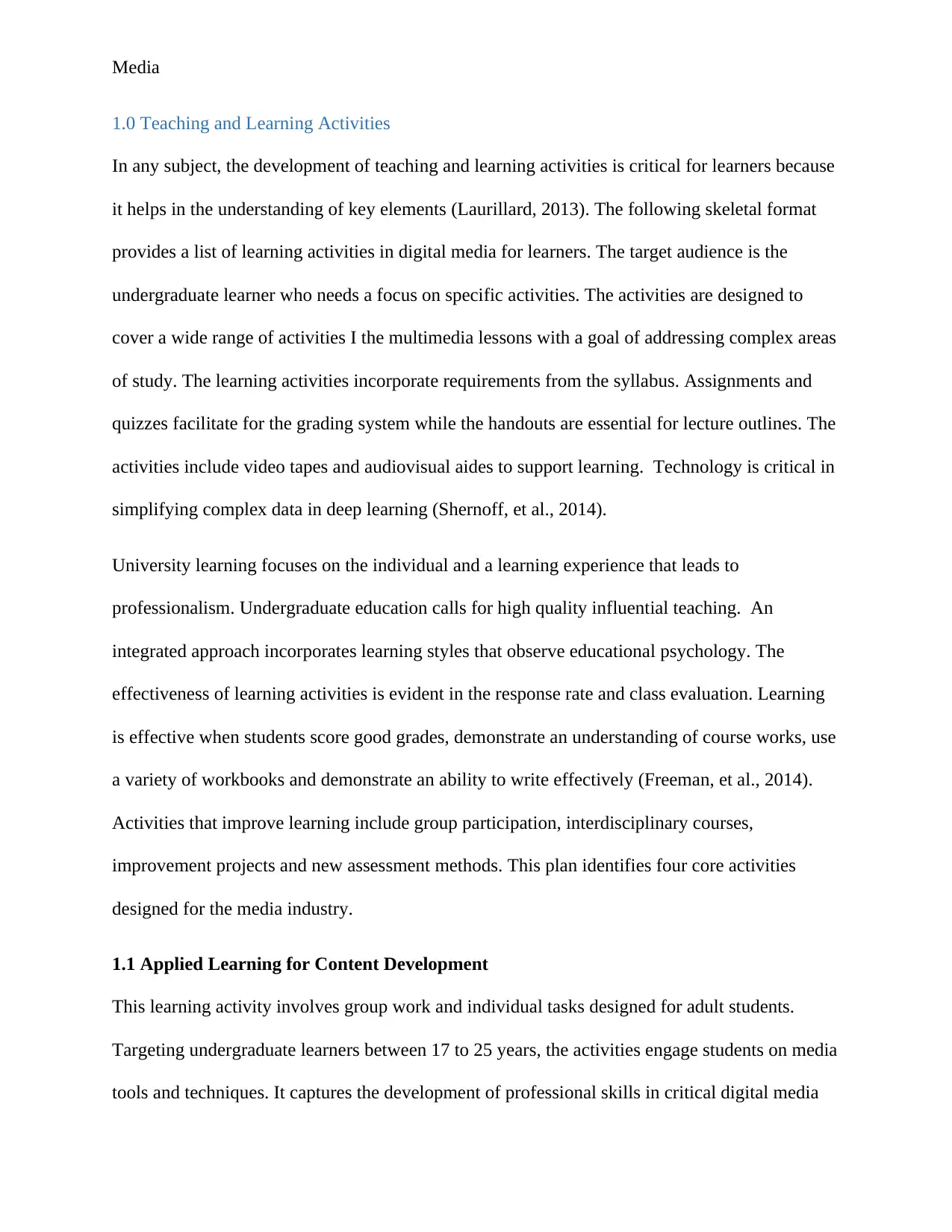
Media
1.0 Teaching and Learning Activities
In any subject, the development of teaching and learning activities is critical for learners because
it helps in the understanding of key elements (Laurillard, 2013). The following skeletal format
provides a list of learning activities in digital media for learners. The target audience is the
undergraduate learner who needs a focus on specific activities. The activities are designed to
cover a wide range of activities I the multimedia lessons with a goal of addressing complex areas
of study. The learning activities incorporate requirements from the syllabus. Assignments and
quizzes facilitate for the grading system while the handouts are essential for lecture outlines. The
activities include video tapes and audiovisual aides to support learning. Technology is critical in
simplifying complex data in deep learning (Shernoff, et al., 2014).
University learning focuses on the individual and a learning experience that leads to
professionalism. Undergraduate education calls for high quality influential teaching. An
integrated approach incorporates learning styles that observe educational psychology. The
effectiveness of learning activities is evident in the response rate and class evaluation. Learning
is effective when students score good grades, demonstrate an understanding of course works, use
a variety of workbooks and demonstrate an ability to write effectively (Freeman, et al., 2014).
Activities that improve learning include group participation, interdisciplinary courses,
improvement projects and new assessment methods. This plan identifies four core activities
designed for the media industry.
1.1 Applied Learning for Content Development
This learning activity involves group work and individual tasks designed for adult students.
Targeting undergraduate learners between 17 to 25 years, the activities engage students on media
tools and techniques. It captures the development of professional skills in critical digital media
1.0 Teaching and Learning Activities
In any subject, the development of teaching and learning activities is critical for learners because
it helps in the understanding of key elements (Laurillard, 2013). The following skeletal format
provides a list of learning activities in digital media for learners. The target audience is the
undergraduate learner who needs a focus on specific activities. The activities are designed to
cover a wide range of activities I the multimedia lessons with a goal of addressing complex areas
of study. The learning activities incorporate requirements from the syllabus. Assignments and
quizzes facilitate for the grading system while the handouts are essential for lecture outlines. The
activities include video tapes and audiovisual aides to support learning. Technology is critical in
simplifying complex data in deep learning (Shernoff, et al., 2014).
University learning focuses on the individual and a learning experience that leads to
professionalism. Undergraduate education calls for high quality influential teaching. An
integrated approach incorporates learning styles that observe educational psychology. The
effectiveness of learning activities is evident in the response rate and class evaluation. Learning
is effective when students score good grades, demonstrate an understanding of course works, use
a variety of workbooks and demonstrate an ability to write effectively (Freeman, et al., 2014).
Activities that improve learning include group participation, interdisciplinary courses,
improvement projects and new assessment methods. This plan identifies four core activities
designed for the media industry.
1.1 Applied Learning for Content Development
This learning activity involves group work and individual tasks designed for adult students.
Targeting undergraduate learners between 17 to 25 years, the activities engage students on media
tools and techniques. It captures the development of professional skills in critical digital media
⊘ This is a preview!⊘
Do you want full access?
Subscribe today to unlock all pages.

Trusted by 1+ million students worldwide
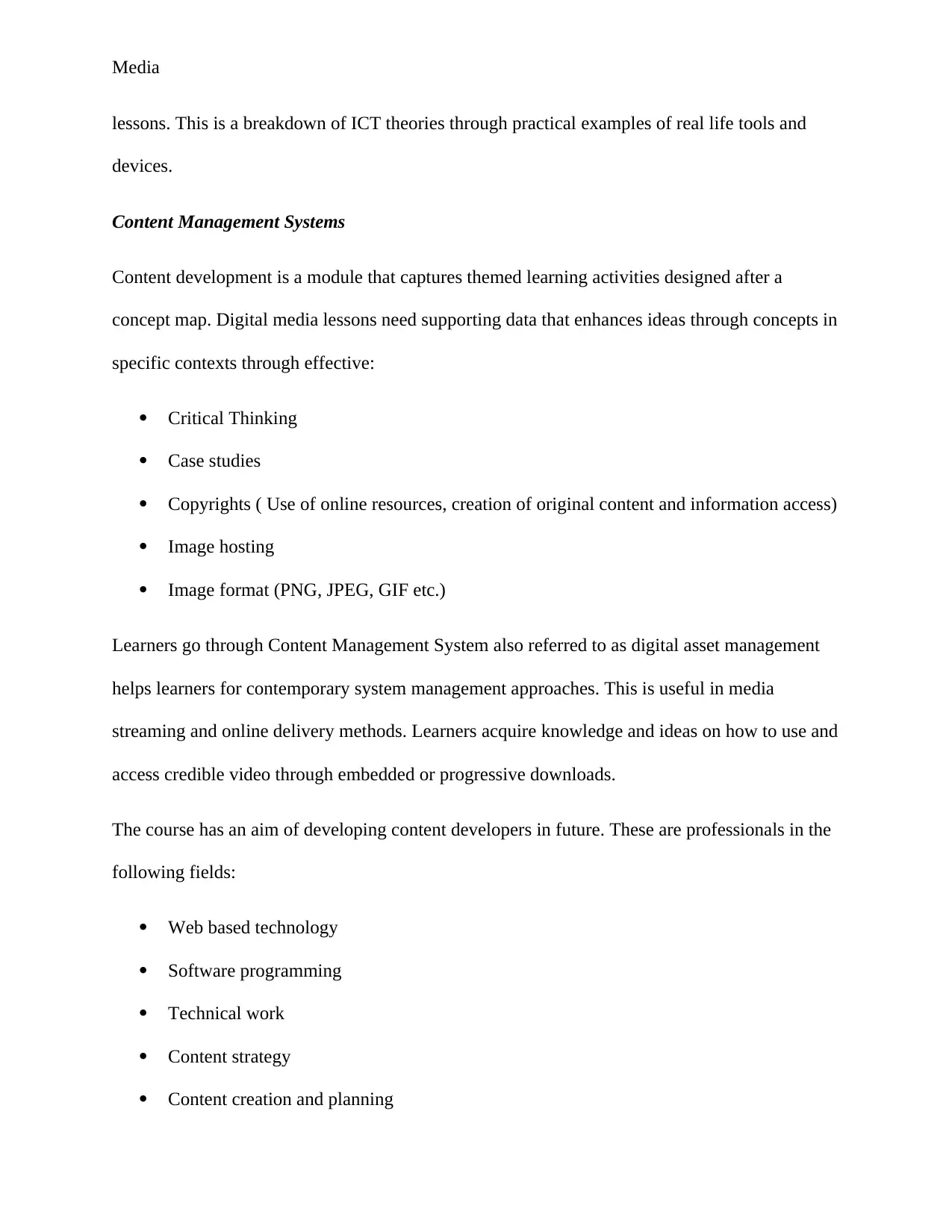
Media
lessons. This is a breakdown of ICT theories through practical examples of real life tools and
devices.
Content Management Systems
Content development is a module that captures themed learning activities designed after a
concept map. Digital media lessons need supporting data that enhances ideas through concepts in
specific contexts through effective:
Critical Thinking
Case studies
Copyrights ( Use of online resources, creation of original content and information access)
Image hosting
Image format (PNG, JPEG, GIF etc.)
Learners go through Content Management System also referred to as digital asset management
helps learners for contemporary system management approaches. This is useful in media
streaming and online delivery methods. Learners acquire knowledge and ideas on how to use and
access credible video through embedded or progressive downloads.
The course has an aim of developing content developers in future. These are professionals in the
following fields:
Web based technology
Software programming
Technical work
Content strategy
Content creation and planning
lessons. This is a breakdown of ICT theories through practical examples of real life tools and
devices.
Content Management Systems
Content development is a module that captures themed learning activities designed after a
concept map. Digital media lessons need supporting data that enhances ideas through concepts in
specific contexts through effective:
Critical Thinking
Case studies
Copyrights ( Use of online resources, creation of original content and information access)
Image hosting
Image format (PNG, JPEG, GIF etc.)
Learners go through Content Management System also referred to as digital asset management
helps learners for contemporary system management approaches. This is useful in media
streaming and online delivery methods. Learners acquire knowledge and ideas on how to use and
access credible video through embedded or progressive downloads.
The course has an aim of developing content developers in future. These are professionals in the
following fields:
Web based technology
Software programming
Technical work
Content strategy
Content creation and planning
Paraphrase This Document
Need a fresh take? Get an instant paraphrase of this document with our AI Paraphraser
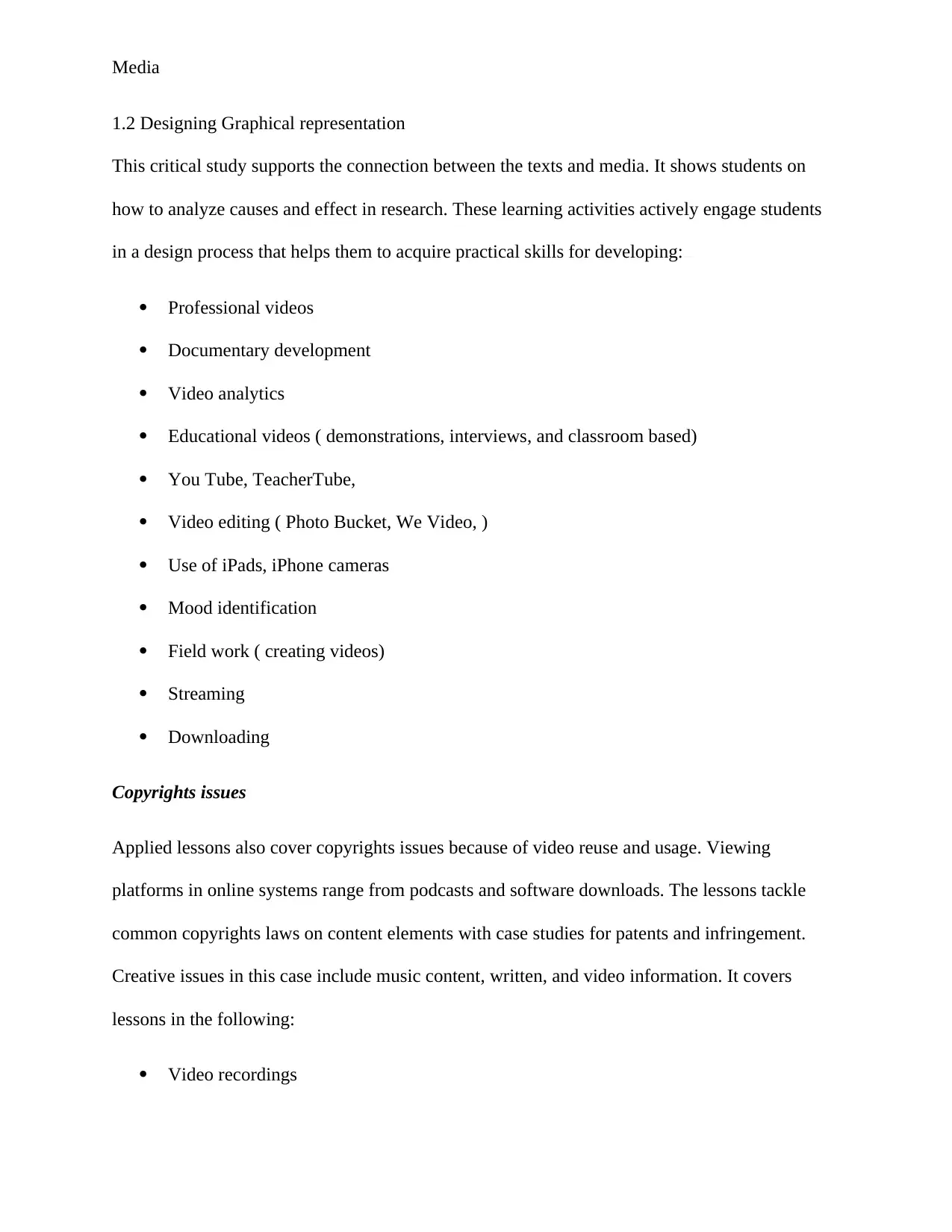
Media
1.2 Designing Graphical representation
This critical study supports the connection between the texts and media. It shows students on
how to analyze causes and effect in research. These learning activities actively engage students
in a design process that helps them to acquire practical skills for developing:
Professional videos
Documentary development
Video analytics
Educational videos ( demonstrations, interviews, and classroom based)
You Tube, TeacherTube,
Video editing ( Photo Bucket, We Video, )
Use of iPads, iPhone cameras
Mood identification
Field work ( creating videos)
Streaming
Downloading
Copyrights issues
Applied lessons also cover copyrights issues because of video reuse and usage. Viewing
platforms in online systems range from podcasts and software downloads. The lessons tackle
common copyrights laws on content elements with case studies for patents and infringement.
Creative issues in this case include music content, written, and video information. It covers
lessons in the following:
Video recordings
1.2 Designing Graphical representation
This critical study supports the connection between the texts and media. It shows students on
how to analyze causes and effect in research. These learning activities actively engage students
in a design process that helps them to acquire practical skills for developing:
Professional videos
Documentary development
Video analytics
Educational videos ( demonstrations, interviews, and classroom based)
You Tube, TeacherTube,
Video editing ( Photo Bucket, We Video, )
Use of iPads, iPhone cameras
Mood identification
Field work ( creating videos)
Streaming
Downloading
Copyrights issues
Applied lessons also cover copyrights issues because of video reuse and usage. Viewing
platforms in online systems range from podcasts and software downloads. The lessons tackle
common copyrights laws on content elements with case studies for patents and infringement.
Creative issues in this case include music content, written, and video information. It covers
lessons in the following:
Video recordings
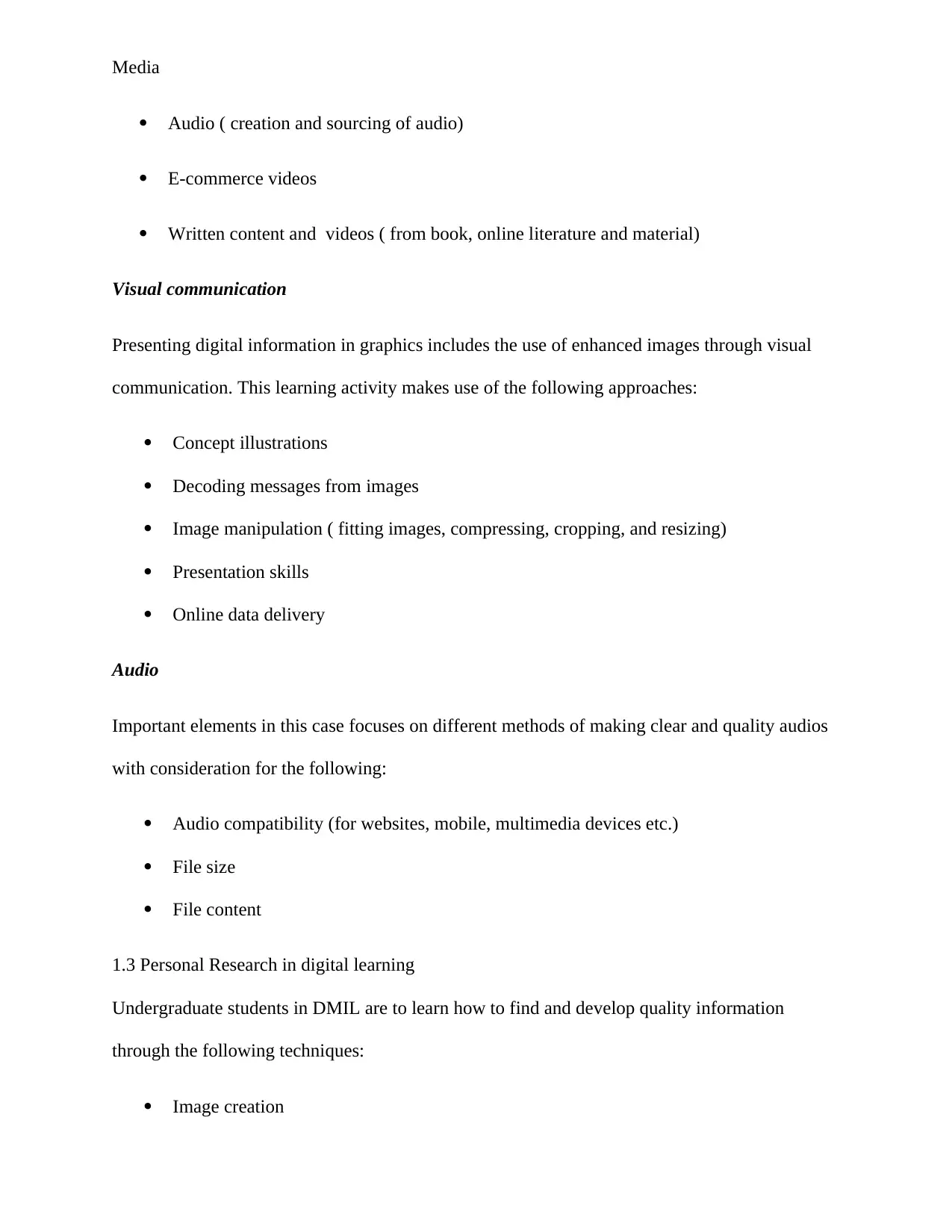
Media
Audio ( creation and sourcing of audio)
E-commerce videos
Written content and videos ( from book, online literature and material)
Visual communication
Presenting digital information in graphics includes the use of enhanced images through visual
communication. This learning activity makes use of the following approaches:
Concept illustrations
Decoding messages from images
Image manipulation ( fitting images, compressing, cropping, and resizing)
Presentation skills
Online data delivery
Audio
Important elements in this case focuses on different methods of making clear and quality audios
with consideration for the following:
Audio compatibility (for websites, mobile, multimedia devices etc.)
File size
File content
1.3 Personal Research in digital learning
Undergraduate students in DMIL are to learn how to find and develop quality information
through the following techniques:
Image creation
Audio ( creation and sourcing of audio)
E-commerce videos
Written content and videos ( from book, online literature and material)
Visual communication
Presenting digital information in graphics includes the use of enhanced images through visual
communication. This learning activity makes use of the following approaches:
Concept illustrations
Decoding messages from images
Image manipulation ( fitting images, compressing, cropping, and resizing)
Presentation skills
Online data delivery
Audio
Important elements in this case focuses on different methods of making clear and quality audios
with consideration for the following:
Audio compatibility (for websites, mobile, multimedia devices etc.)
File size
File content
1.3 Personal Research in digital learning
Undergraduate students in DMIL are to learn how to find and develop quality information
through the following techniques:
Image creation
⊘ This is a preview!⊘
Do you want full access?
Subscribe today to unlock all pages.

Trusted by 1+ million students worldwide
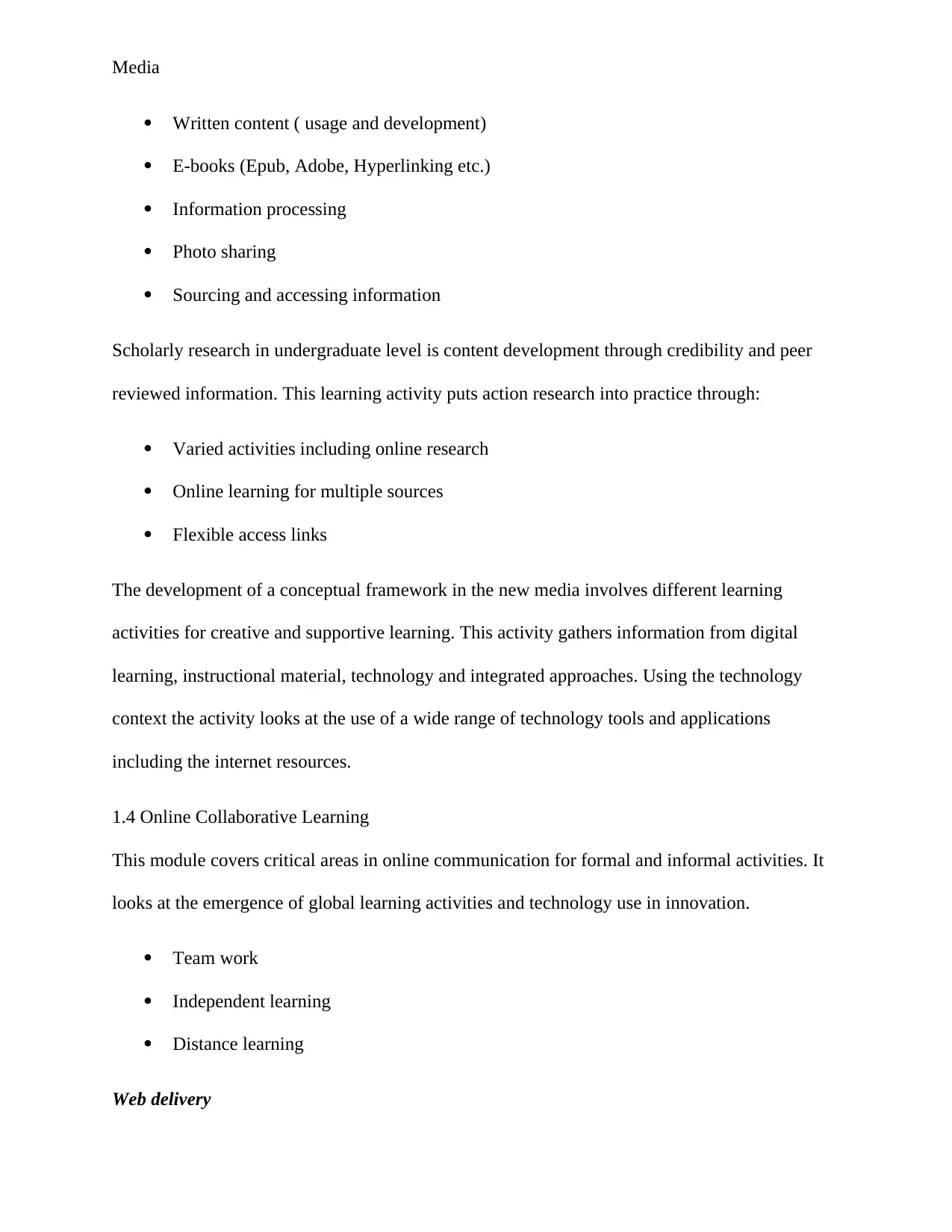
Media
Written content ( usage and development)
E-books (Epub, Adobe, Hyperlinking etc.)
Information processing
Photo sharing
Sourcing and accessing information
Scholarly research in undergraduate level is content development through credibility and peer
reviewed information. This learning activity puts action research into practice through:
Varied activities including online research
Online learning for multiple sources
Flexible access links
The development of a conceptual framework in the new media involves different learning
activities for creative and supportive learning. This activity gathers information from digital
learning, instructional material, technology and integrated approaches. Using the technology
context the activity looks at the use of a wide range of technology tools and applications
including the internet resources.
1.4 Online Collaborative Learning
This module covers critical areas in online communication for formal and informal activities. It
looks at the emergence of global learning activities and technology use in innovation.
Team work
Independent learning
Distance learning
Web delivery
Written content ( usage and development)
E-books (Epub, Adobe, Hyperlinking etc.)
Information processing
Photo sharing
Sourcing and accessing information
Scholarly research in undergraduate level is content development through credibility and peer
reviewed information. This learning activity puts action research into practice through:
Varied activities including online research
Online learning for multiple sources
Flexible access links
The development of a conceptual framework in the new media involves different learning
activities for creative and supportive learning. This activity gathers information from digital
learning, instructional material, technology and integrated approaches. Using the technology
context the activity looks at the use of a wide range of technology tools and applications
including the internet resources.
1.4 Online Collaborative Learning
This module covers critical areas in online communication for formal and informal activities. It
looks at the emergence of global learning activities and technology use in innovation.
Team work
Independent learning
Distance learning
Web delivery
Paraphrase This Document
Need a fresh take? Get an instant paraphrase of this document with our AI Paraphraser
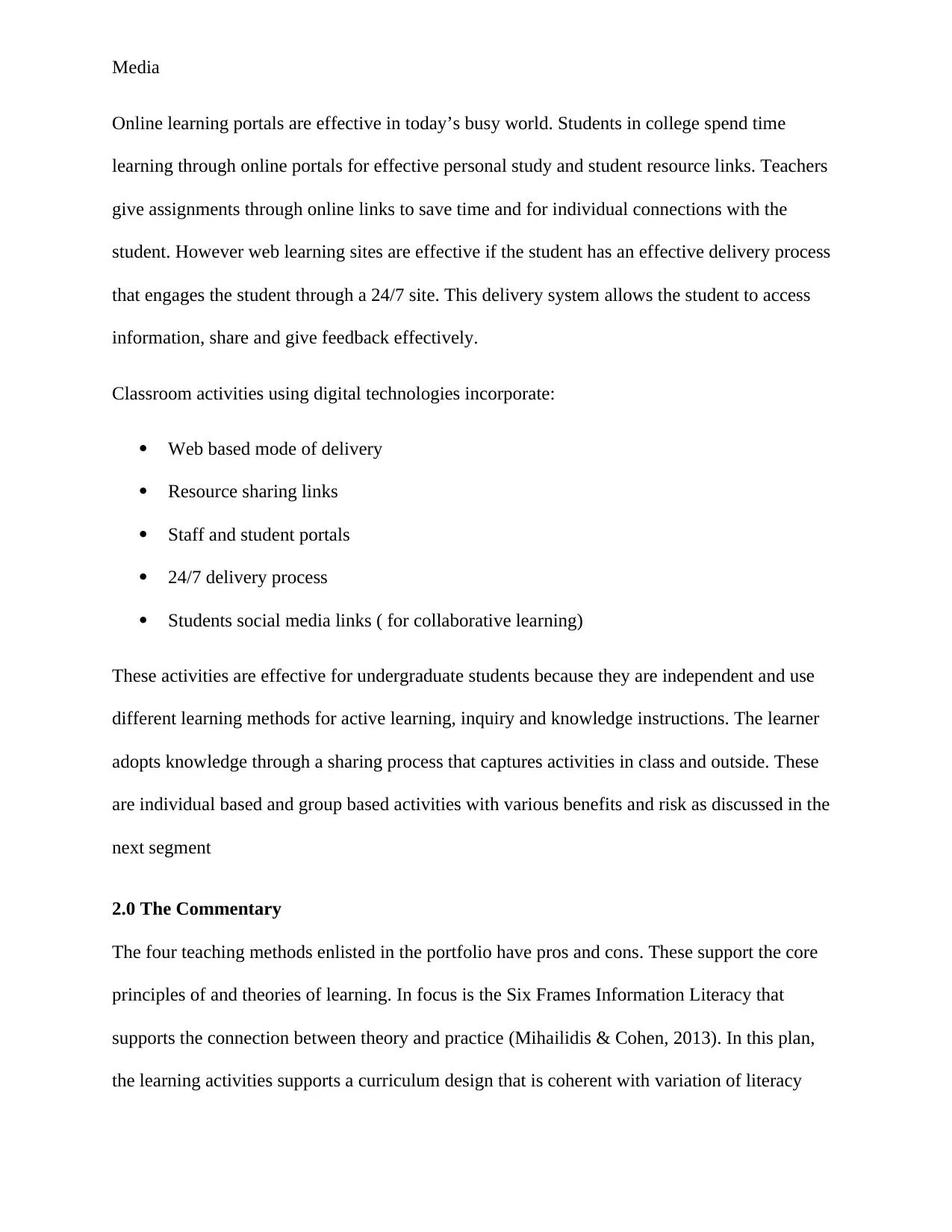
Media
Online learning portals are effective in today’s busy world. Students in college spend time
learning through online portals for effective personal study and student resource links. Teachers
give assignments through online links to save time and for individual connections with the
student. However web learning sites are effective if the student has an effective delivery process
that engages the student through a 24/7 site. This delivery system allows the student to access
information, share and give feedback effectively.
Classroom activities using digital technologies incorporate:
Web based mode of delivery
Resource sharing links
Staff and student portals
24/7 delivery process
Students social media links ( for collaborative learning)
These activities are effective for undergraduate students because they are independent and use
different learning methods for active learning, inquiry and knowledge instructions. The learner
adopts knowledge through a sharing process that captures activities in class and outside. These
are individual based and group based activities with various benefits and risk as discussed in the
next segment
2.0 The Commentary
The four teaching methods enlisted in the portfolio have pros and cons. These support the core
principles of and theories of learning. In focus is the Six Frames Information Literacy that
supports the connection between theory and practice (Mihailidis & Cohen, 2013). In this plan,
the learning activities supports a curriculum design that is coherent with variation of literacy
Online learning portals are effective in today’s busy world. Students in college spend time
learning through online portals for effective personal study and student resource links. Teachers
give assignments through online links to save time and for individual connections with the
student. However web learning sites are effective if the student has an effective delivery process
that engages the student through a 24/7 site. This delivery system allows the student to access
information, share and give feedback effectively.
Classroom activities using digital technologies incorporate:
Web based mode of delivery
Resource sharing links
Staff and student portals
24/7 delivery process
Students social media links ( for collaborative learning)
These activities are effective for undergraduate students because they are independent and use
different learning methods for active learning, inquiry and knowledge instructions. The learner
adopts knowledge through a sharing process that captures activities in class and outside. These
are individual based and group based activities with various benefits and risk as discussed in the
next segment
2.0 The Commentary
The four teaching methods enlisted in the portfolio have pros and cons. These support the core
principles of and theories of learning. In focus is the Six Frames Information Literacy that
supports the connection between theory and practice (Mihailidis & Cohen, 2013). In this plan,
the learning activities supports a curriculum design that is coherent with variation of literacy
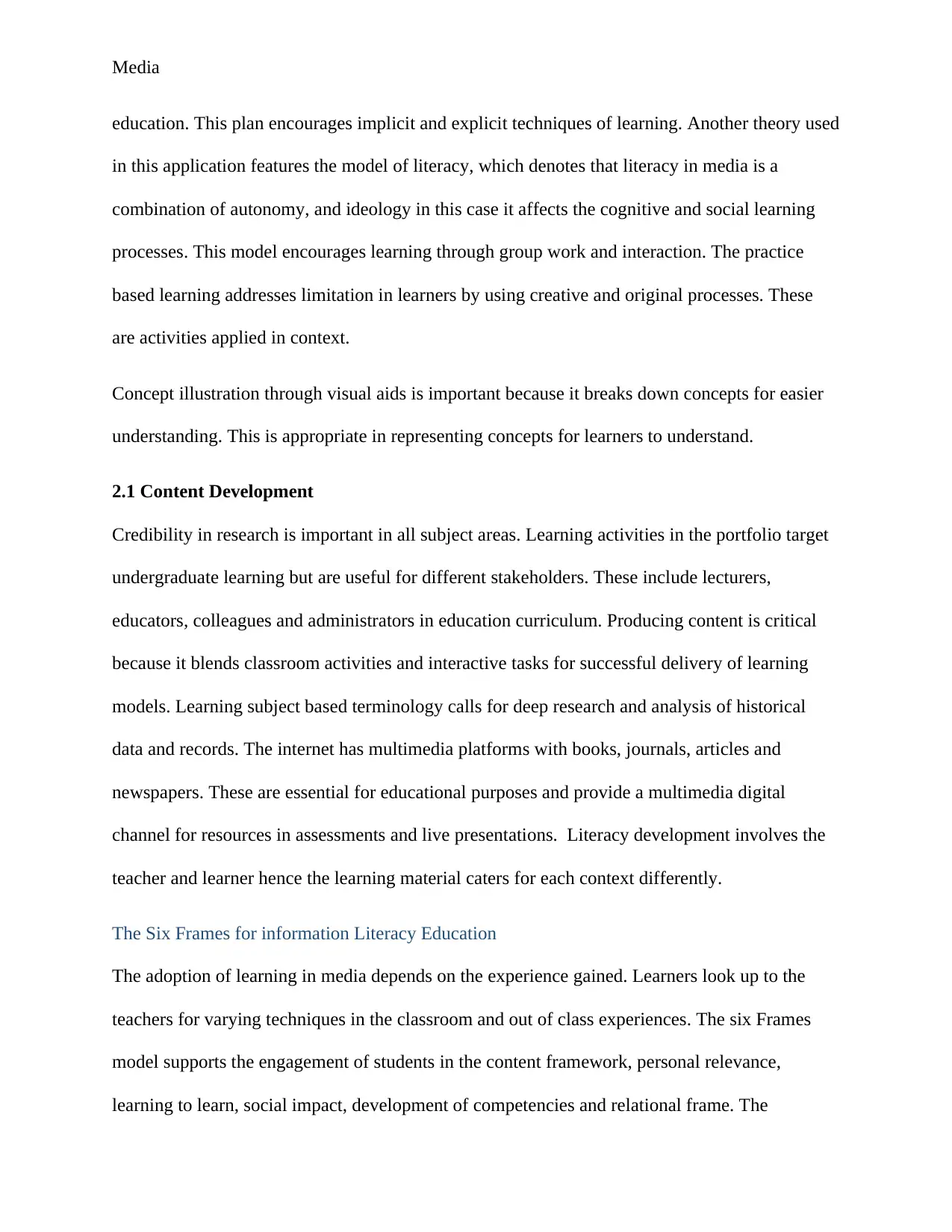
Media
education. This plan encourages implicit and explicit techniques of learning. Another theory used
in this application features the model of literacy, which denotes that literacy in media is a
combination of autonomy, and ideology in this case it affects the cognitive and social learning
processes. This model encourages learning through group work and interaction. The practice
based learning addresses limitation in learners by using creative and original processes. These
are activities applied in context.
Concept illustration through visual aids is important because it breaks down concepts for easier
understanding. This is appropriate in representing concepts for learners to understand.
2.1 Content Development
Credibility in research is important in all subject areas. Learning activities in the portfolio target
undergraduate learning but are useful for different stakeholders. These include lecturers,
educators, colleagues and administrators in education curriculum. Producing content is critical
because it blends classroom activities and interactive tasks for successful delivery of learning
models. Learning subject based terminology calls for deep research and analysis of historical
data and records. The internet has multimedia platforms with books, journals, articles and
newspapers. These are essential for educational purposes and provide a multimedia digital
channel for resources in assessments and live presentations. Literacy development involves the
teacher and learner hence the learning material caters for each context differently.
The Six Frames for information Literacy Education
The adoption of learning in media depends on the experience gained. Learners look up to the
teachers for varying techniques in the classroom and out of class experiences. The six Frames
model supports the engagement of students in the content framework, personal relevance,
learning to learn, social impact, development of competencies and relational frame. The
education. This plan encourages implicit and explicit techniques of learning. Another theory used
in this application features the model of literacy, which denotes that literacy in media is a
combination of autonomy, and ideology in this case it affects the cognitive and social learning
processes. This model encourages learning through group work and interaction. The practice
based learning addresses limitation in learners by using creative and original processes. These
are activities applied in context.
Concept illustration through visual aids is important because it breaks down concepts for easier
understanding. This is appropriate in representing concepts for learners to understand.
2.1 Content Development
Credibility in research is important in all subject areas. Learning activities in the portfolio target
undergraduate learning but are useful for different stakeholders. These include lecturers,
educators, colleagues and administrators in education curriculum. Producing content is critical
because it blends classroom activities and interactive tasks for successful delivery of learning
models. Learning subject based terminology calls for deep research and analysis of historical
data and records. The internet has multimedia platforms with books, journals, articles and
newspapers. These are essential for educational purposes and provide a multimedia digital
channel for resources in assessments and live presentations. Literacy development involves the
teacher and learner hence the learning material caters for each context differently.
The Six Frames for information Literacy Education
The adoption of learning in media depends on the experience gained. Learners look up to the
teachers for varying techniques in the classroom and out of class experiences. The six Frames
model supports the engagement of students in the content framework, personal relevance,
learning to learn, social impact, development of competencies and relational frame. The
⊘ This is a preview!⊘
Do you want full access?
Subscribe today to unlock all pages.

Trusted by 1+ million students worldwide
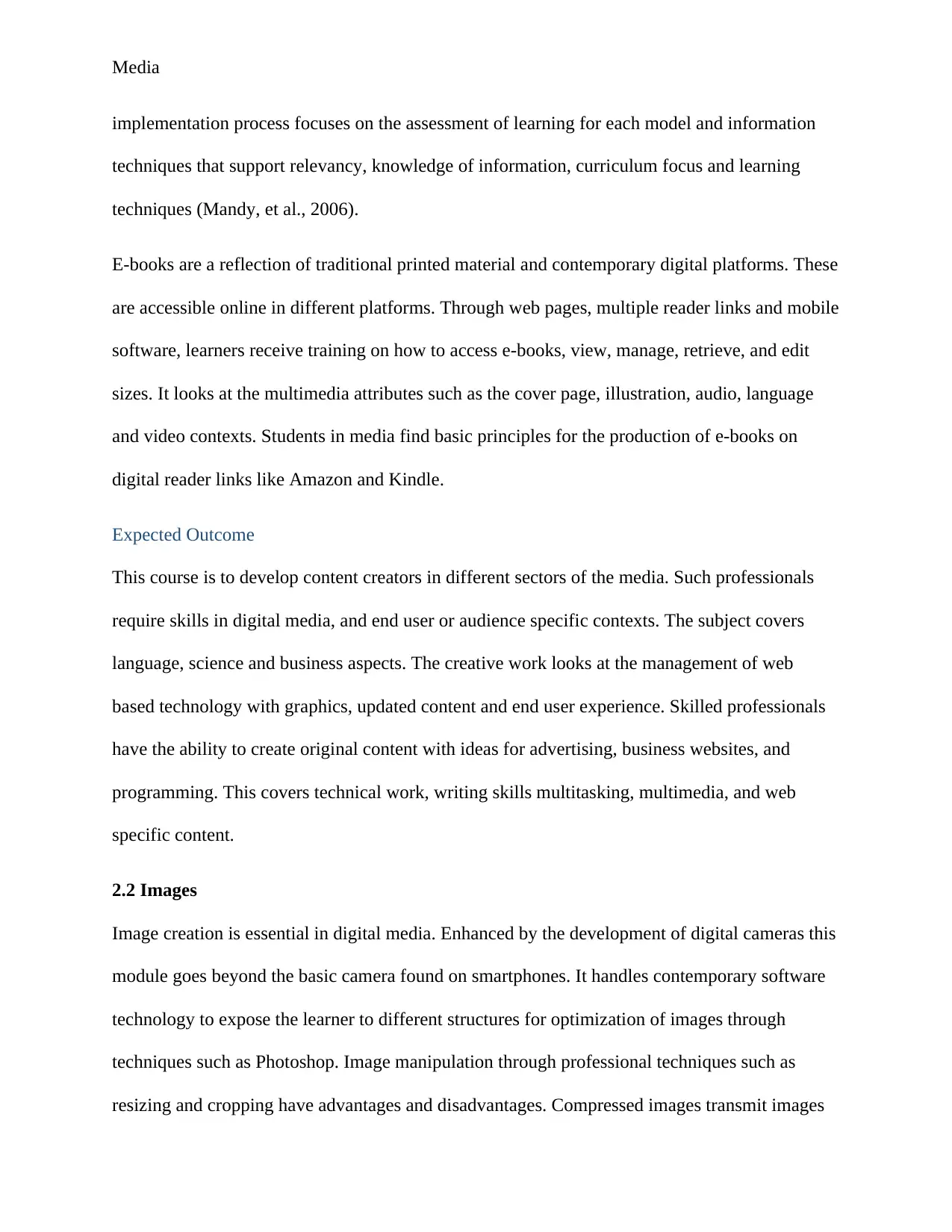
Media
implementation process focuses on the assessment of learning for each model and information
techniques that support relevancy, knowledge of information, curriculum focus and learning
techniques (Mandy, et al., 2006).
E-books are a reflection of traditional printed material and contemporary digital platforms. These
are accessible online in different platforms. Through web pages, multiple reader links and mobile
software, learners receive training on how to access e-books, view, manage, retrieve, and edit
sizes. It looks at the multimedia attributes such as the cover page, illustration, audio, language
and video contexts. Students in media find basic principles for the production of e-books on
digital reader links like Amazon and Kindle.
Expected Outcome
This course is to develop content creators in different sectors of the media. Such professionals
require skills in digital media, and end user or audience specific contexts. The subject covers
language, science and business aspects. The creative work looks at the management of web
based technology with graphics, updated content and end user experience. Skilled professionals
have the ability to create original content with ideas for advertising, business websites, and
programming. This covers technical work, writing skills multitasking, multimedia, and web
specific content.
2.2 Images
Image creation is essential in digital media. Enhanced by the development of digital cameras this
module goes beyond the basic camera found on smartphones. It handles contemporary software
technology to expose the learner to different structures for optimization of images through
techniques such as Photoshop. Image manipulation through professional techniques such as
resizing and cropping have advantages and disadvantages. Compressed images transmit images
implementation process focuses on the assessment of learning for each model and information
techniques that support relevancy, knowledge of information, curriculum focus and learning
techniques (Mandy, et al., 2006).
E-books are a reflection of traditional printed material and contemporary digital platforms. These
are accessible online in different platforms. Through web pages, multiple reader links and mobile
software, learners receive training on how to access e-books, view, manage, retrieve, and edit
sizes. It looks at the multimedia attributes such as the cover page, illustration, audio, language
and video contexts. Students in media find basic principles for the production of e-books on
digital reader links like Amazon and Kindle.
Expected Outcome
This course is to develop content creators in different sectors of the media. Such professionals
require skills in digital media, and end user or audience specific contexts. The subject covers
language, science and business aspects. The creative work looks at the management of web
based technology with graphics, updated content and end user experience. Skilled professionals
have the ability to create original content with ideas for advertising, business websites, and
programming. This covers technical work, writing skills multitasking, multimedia, and web
specific content.
2.2 Images
Image creation is essential in digital media. Enhanced by the development of digital cameras this
module goes beyond the basic camera found on smartphones. It handles contemporary software
technology to expose the learner to different structures for optimization of images through
techniques such as Photoshop. Image manipulation through professional techniques such as
resizing and cropping have advantages and disadvantages. Compressed images transmit images
Paraphrase This Document
Need a fresh take? Get an instant paraphrase of this document with our AI Paraphraser
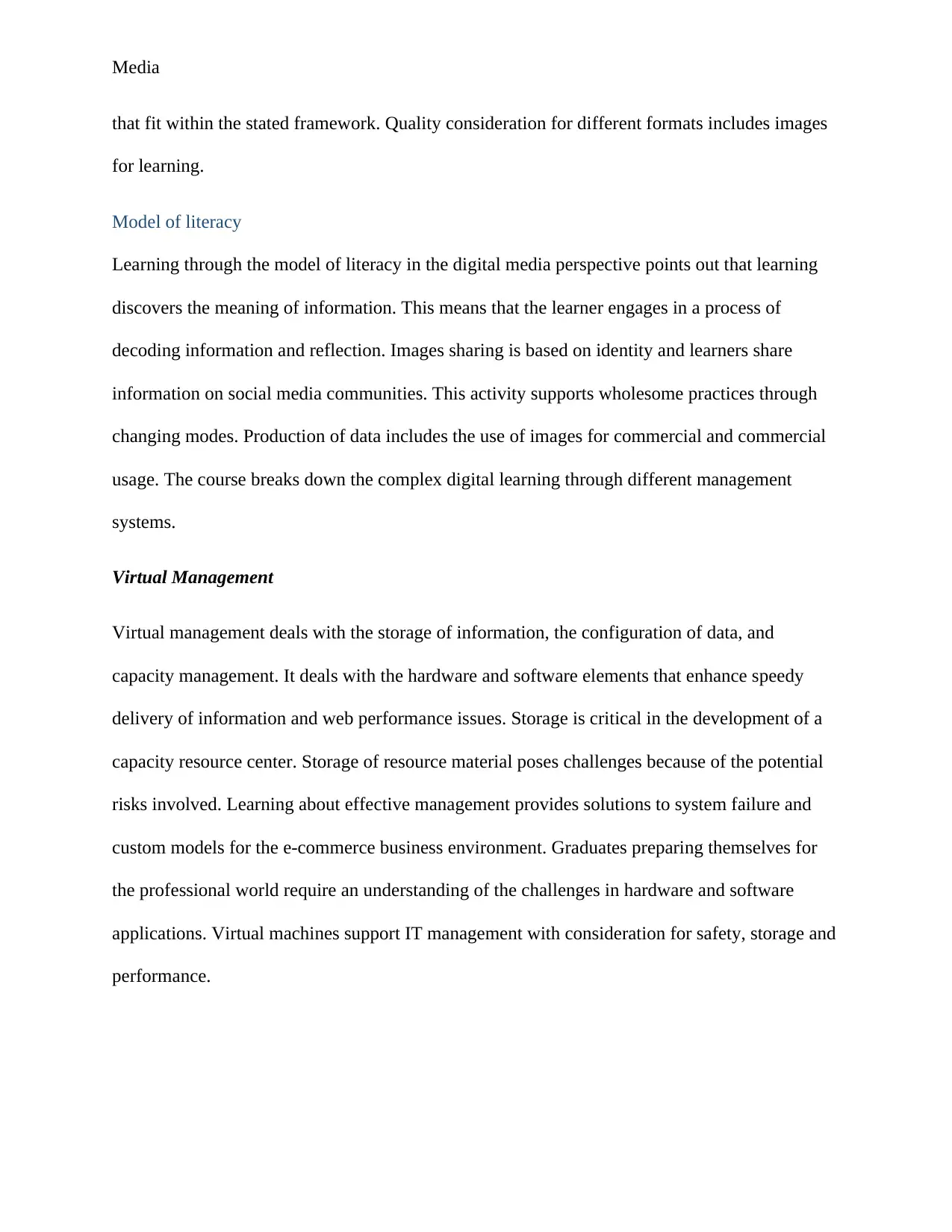
Media
that fit within the stated framework. Quality consideration for different formats includes images
for learning.
Model of literacy
Learning through the model of literacy in the digital media perspective points out that learning
discovers the meaning of information. This means that the learner engages in a process of
decoding information and reflection. Images sharing is based on identity and learners share
information on social media communities. This activity supports wholesome practices through
changing modes. Production of data includes the use of images for commercial and commercial
usage. The course breaks down the complex digital learning through different management
systems.
Virtual Management
Virtual management deals with the storage of information, the configuration of data, and
capacity management. It deals with the hardware and software elements that enhance speedy
delivery of information and web performance issues. Storage is critical in the development of a
capacity resource center. Storage of resource material poses challenges because of the potential
risks involved. Learning about effective management provides solutions to system failure and
custom models for the e-commerce business environment. Graduates preparing themselves for
the professional world require an understanding of the challenges in hardware and software
applications. Virtual machines support IT management with consideration for safety, storage and
performance.
that fit within the stated framework. Quality consideration for different formats includes images
for learning.
Model of literacy
Learning through the model of literacy in the digital media perspective points out that learning
discovers the meaning of information. This means that the learner engages in a process of
decoding information and reflection. Images sharing is based on identity and learners share
information on social media communities. This activity supports wholesome practices through
changing modes. Production of data includes the use of images for commercial and commercial
usage. The course breaks down the complex digital learning through different management
systems.
Virtual Management
Virtual management deals with the storage of information, the configuration of data, and
capacity management. It deals with the hardware and software elements that enhance speedy
delivery of information and web performance issues. Storage is critical in the development of a
capacity resource center. Storage of resource material poses challenges because of the potential
risks involved. Learning about effective management provides solutions to system failure and
custom models for the e-commerce business environment. Graduates preparing themselves for
the professional world require an understanding of the challenges in hardware and software
applications. Virtual machines support IT management with consideration for safety, storage and
performance.
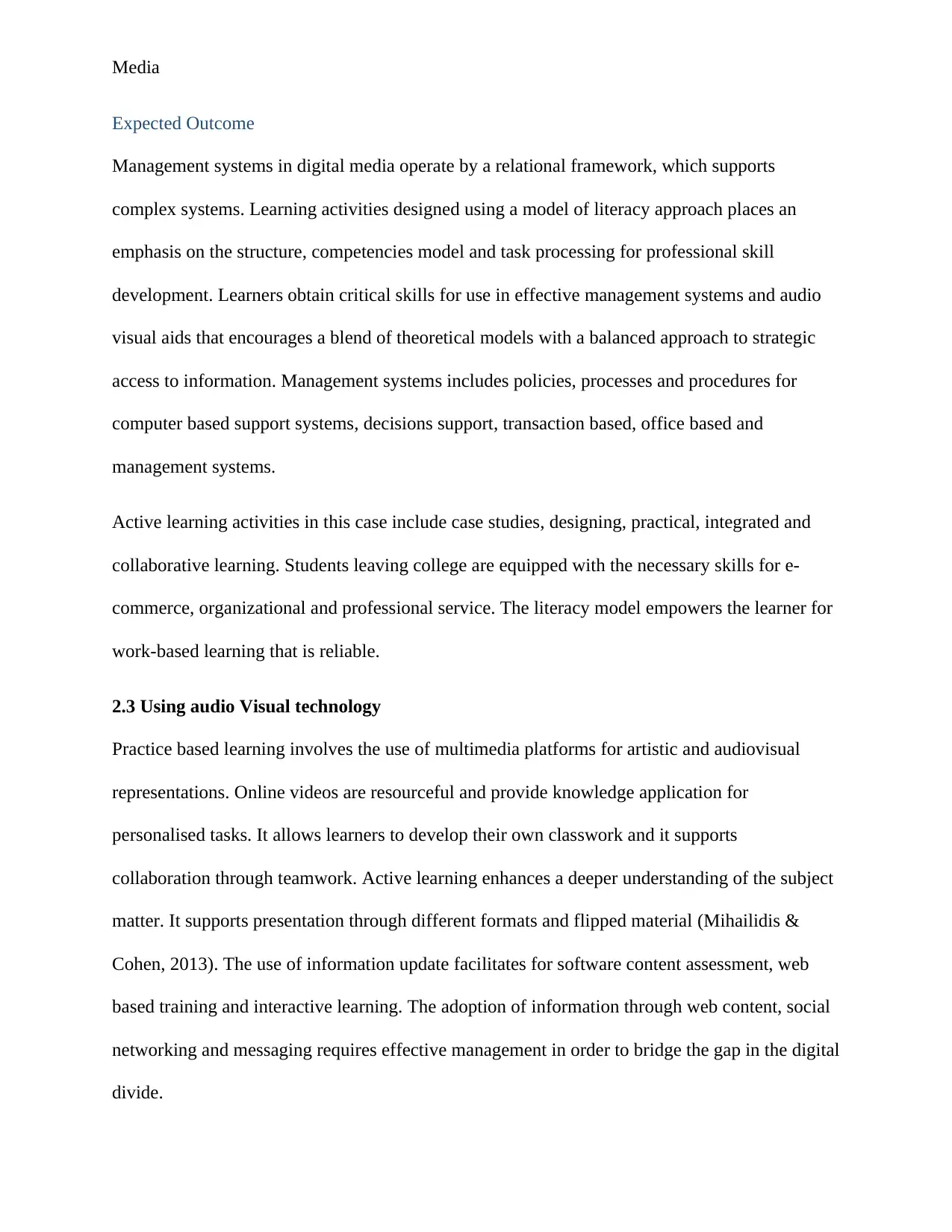
Media
Expected Outcome
Management systems in digital media operate by a relational framework, which supports
complex systems. Learning activities designed using a model of literacy approach places an
emphasis on the structure, competencies model and task processing for professional skill
development. Learners obtain critical skills for use in effective management systems and audio
visual aids that encourages a blend of theoretical models with a balanced approach to strategic
access to information. Management systems includes policies, processes and procedures for
computer based support systems, decisions support, transaction based, office based and
management systems.
Active learning activities in this case include case studies, designing, practical, integrated and
collaborative learning. Students leaving college are equipped with the necessary skills for e-
commerce, organizational and professional service. The literacy model empowers the learner for
work-based learning that is reliable.
2.3 Using audio Visual technology
Practice based learning involves the use of multimedia platforms for artistic and audiovisual
representations. Online videos are resourceful and provide knowledge application for
personalised tasks. It allows learners to develop their own classwork and it supports
collaboration through teamwork. Active learning enhances a deeper understanding of the subject
matter. It supports presentation through different formats and flipped material (Mihailidis &
Cohen, 2013). The use of information update facilitates for software content assessment, web
based training and interactive learning. The adoption of information through web content, social
networking and messaging requires effective management in order to bridge the gap in the digital
divide.
Expected Outcome
Management systems in digital media operate by a relational framework, which supports
complex systems. Learning activities designed using a model of literacy approach places an
emphasis on the structure, competencies model and task processing for professional skill
development. Learners obtain critical skills for use in effective management systems and audio
visual aids that encourages a blend of theoretical models with a balanced approach to strategic
access to information. Management systems includes policies, processes and procedures for
computer based support systems, decisions support, transaction based, office based and
management systems.
Active learning activities in this case include case studies, designing, practical, integrated and
collaborative learning. Students leaving college are equipped with the necessary skills for e-
commerce, organizational and professional service. The literacy model empowers the learner for
work-based learning that is reliable.
2.3 Using audio Visual technology
Practice based learning involves the use of multimedia platforms for artistic and audiovisual
representations. Online videos are resourceful and provide knowledge application for
personalised tasks. It allows learners to develop their own classwork and it supports
collaboration through teamwork. Active learning enhances a deeper understanding of the subject
matter. It supports presentation through different formats and flipped material (Mihailidis &
Cohen, 2013). The use of information update facilitates for software content assessment, web
based training and interactive learning. The adoption of information through web content, social
networking and messaging requires effective management in order to bridge the gap in the digital
divide.
⊘ This is a preview!⊘
Do you want full access?
Subscribe today to unlock all pages.

Trusted by 1+ million students worldwide
1 out of 18
Related Documents
Your All-in-One AI-Powered Toolkit for Academic Success.
+13062052269
info@desklib.com
Available 24*7 on WhatsApp / Email
![[object Object]](/_next/static/media/star-bottom.7253800d.svg)
Unlock your academic potential
Copyright © 2020–2025 A2Z Services. All Rights Reserved. Developed and managed by ZUCOL.




